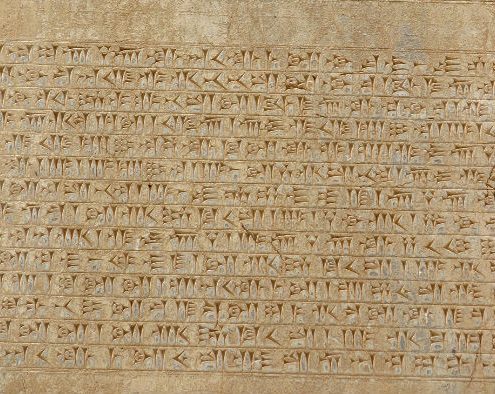Iranian Languages

Cuneiform Script on Persepolis Walls for Ancient Iranian Language
About 3000 years ago, the inhabitants of Iranian plateau and its sub-divisions were speaking languages called Irano-Aryan languages.
These languages are still spoken in the regions beyond the present borders of Iran, from Turkey to Pamir and from Caucasus Mountains to Oman Sea.
The common origin of all these languages was spoken at least since 2000 B.C. All of them had some feature in common: Iranian lexicon and grammatical structure.
The Irano-Aryan languages are within a more general branch called Indo-European. Because of the similarities between Indian languages and Irano-Aryan languages, during the early stages of the evolution of these languages, a branch called Indo-Iranian languages has been formed.
The History of the Irano-Aryan Languages
The history of the Irano-Aryan languages is divided to three main phases:
- Old Iranian: from early 2nd millennium to 4th & 3rd centuries B.C.
- Middle Iranian: from 4th &3rd centuries B.C. to 8th & 9th A.D.
- New Iranian: from 8th & 9th centuries A.D. to today.
The Old Iranian
Undoubtedly Aryan immigrants dispersed in different parts of Asia. Other languages previously spoken in those regions subsequently influenced their language. It was the beginning of several dialects in the Irano-Aryan languages.
One of the deserts in central Iran, Kavir-e-Lut, was the dividing line between the Eastern dialects (Khorasmian, Sogdanian, Bactrian, Margianean) and the Western dialect (Median).
The only reliable source to explore the Old Iranian (Persian) language is the cuneiforms containing kings? orders and the events of that period. Avesta, the holy book of Zoroastrians, with its two dialects stands as a major source to explore the Middle Iranian (Persian).
The Middle Iranian
Between the Old Iranian and the Middle Iranian, there is a six-century gap (4th century B.C.- 3rd century A.D.) of which no written object has yet been discovered. But some fundamental changes had occurred in the whole grammar. Besides, the conjugational system had totally vanished.
The Eastern Iranian languages had also undergone such changes though in smaller scales. Most of the writings of this period were derived from Aramaic writing system. In general, the Middle Iranian was a direct continuation of the Old Iranian.
Pahlavi was the language spoken by Iranians during Parthians. When Arabs attacked Iran, Iranians spoke the Middle Persian. In Sogdiana, there were two dialects based on their religions: 1) Christian Sogdianian, and 2) Manichean Sogdianian.
Khorasmian was a language related to Sogdianian spoken at least from 3rd century A.D. to 12th and 13th centuries A.D. Between the Black sea and China, there was spoken another language, Scythian, since 1st Millennium B.C. for 2000 years. Turkish, later, replaced it. Bactrian was another language that was spoken at today?s north Afghanistan.
The New Iranian
The New Iranian, which was spoken in Sassanian court (Darbar) and capital, Ctesiphon, was called Dary and replaced gradually other Middle Iranian languages, specially in cities, during the 9th and 10th centuries A.D. This language has a remarkable share in the world?s culture and has introduced literary works by the people like Roodaky , Ferdosy, Khayyam, Hafez, Sa?dy, Jamy, Avicenna, etc.
It turned to become not only the literary and written language of the Persian speaking people of central Asia and Iran, but also the language of the Near East and Middle East people like Azerbaijanis, Kurds, Afghans, Indians, Central Asians, Turks, etc.
Farsi, the New Iranian, is the direct continuation of the Middle Iranian?s evolution although the grammatical system of some parts of speech, like verbs, has changed. Dary Farsi is the mother language of both contemporary literary Farsi and contemporary literary Tajiki.
Farsi Today
Today, Farsi is the language spoken and understood in all corners of Iran. It is the official language used in education and administration systems of Iran. Farsi is the mother tongue of the absolute majority of the population in Iran. Beyond the present borders of Iran, there are small groups of Farsi speaking people called Iranians.
Other Farsi Dialects Spoken Today
Tajiki dialects are referred to a large variety of dialects spoken in Afghanistan, being in connection with the Farsi dialects in central Tajiki dialects, Khorasan province dialects and Sistan province. But, Pashto is the dominant language spoken in Afghanistan. Since the former Soviet Union period, Tajiki was the language spoken by the people living in Uzbekistan, Kyrgyzstan and Kazakhstan. It is also the official language of Tajikistan.
Ossetic dialects are referred to the dialects spoken by Ossetians who are living in central Caucasia. Their language, including two major dialects, is the continuation of the western Scythian dialects of antiquity.
Kurdish is another Iranian language spoken by Kurds in a vast mountainous region including part of Iran, Turkey, Iraq and Syria. There are also Kurdish-speaking minor groups living in Khorasan, Central Turkey, other parts of Syria, Azerbaijan, Turkmenistan, Armenia, Georgia, etc.
Lurish and Bakhtiari dialects are spoken in the south of the region where Kurds are living in Iran.
Baluchi is mainly spoken in the historical province of Baluchestan extended from Iran to Pakistan and southern part of Afghanistan. Some Baluchi speaking-people are also living in Turkmenistan.
Tati is another dialect of Iranian language spoken in the republic of Azerbaijan and parts of Dagestan.
Taleshi is spoken in the republic of Azerbaijan and NW of Iran by the Caspian Sea.
Mazandarani and Gilaki are other dialects spoken along the southern coast of the Caspian Sea. They are the continuation of northwest Iranian dialects.
Other Dialects inside Iran
Almost all of the above said languages are spoken in different dialects. In addition, there are many other local dialects in central and western Iran that have not been satisfactorily investigated.
The geographical extents to which the Iranian languages have been transferred are, in short, indicative of the widespread Iranian culture outside of the geographical borders of present-day Iran.
